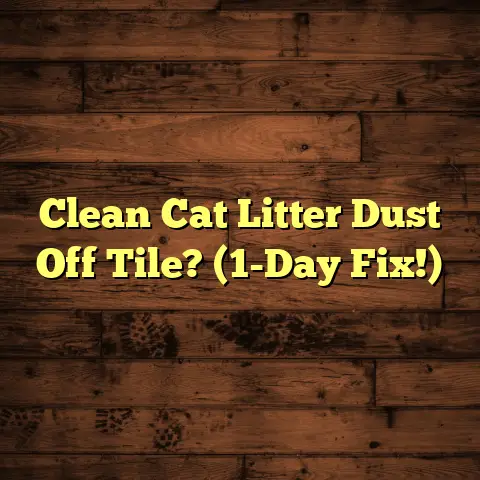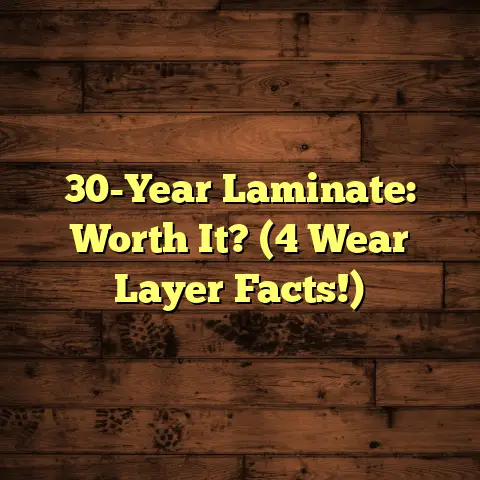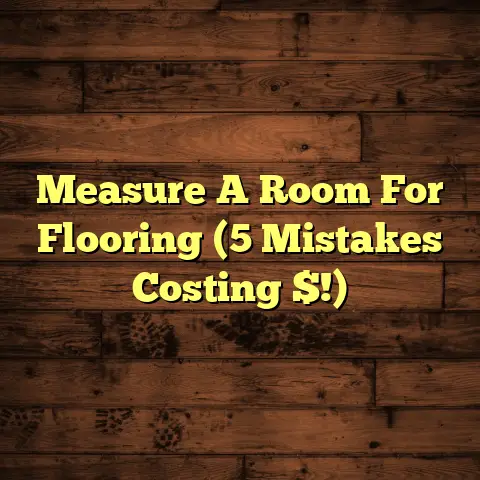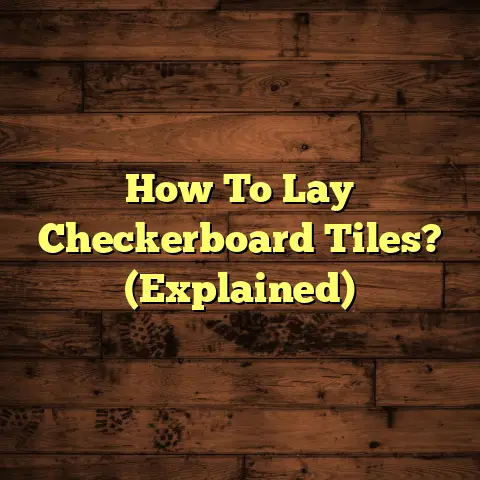Epoxy Over Asbestos Tile? Read This! (7 Risks!)
Have you ever stopped to think about how that trendy flooring you’re eyeing might actually impact your health?
It’s a wild thought, right?
But when it comes to home renovations, especially dealing with older homes, what looks good can sometimes hide a not-so-pretty secret.
Let’s dive into the world of asbestos tiles and epoxy flooring, and why slapping epoxy over those old tiles might be a bigger risk than you think.
Introduction
Asbestos tiles.
You’ve probably heard the name, maybe even seen them in older homes.
They were super popular back in the day.
Think mid-20th century, because they were durable, fire-resistant, and cheap.
But here’s the kicker: they contain asbestos, a mineral that’s now known to be seriously harmful.
Now, fast forward to today.
Epoxy flooring is all the rage.
It’s sleek, modern, and comes in every color imaginable.
Plus, it’s tough as nails.
So, naturally, some homeowners think, “Hey, why not just pour epoxy over these old asbestos tiles and call it a day?”
Well, that’s what we are going to be talking about today.
I’m here to tell you why that might be a really, really bad idea.
This article is all about outlining the risks of going down that path.
We’re talking health risks, legal nightmares, and even financial disasters.
So, buckle up, because this is important stuff.
Understanding Asbestos and Its Risks
Okay, let’s get down to the nitty-gritty.
What exactly is asbestos?
It’s a naturally occurring mineral made up of tiny fibers.
These fibers are incredibly strong and resistant to heat, chemicals, and electricity.
That’s why it was used in everything from insulation to brake pads.
Asbestos was like the superhero of construction materials.
But like many superheroes, it had a dark side.
When asbestos fibers are inhaled, they can get lodged in your lungs.
Over time, this can lead to some really nasty diseases, like:
- Mesothelioma: A rare and aggressive cancer that affects the lining of the lungs, abdomen, or heart.
- Lung Cancer: Asbestos exposure significantly increases the risk of developing lung cancer.
- Asbestosis: A chronic lung disease that causes scarring and shortness of breath.
- Other Lung Diseases: Pleural plaques, pleural thickening, and other respiratory problems.
These diseases can take decades to develop, which is part of what makes asbestos so dangerous.
You might be exposed today and not see the consequences for 20, 30, or even 40 years.
That’s why governments around the world have put strict regulations in place to control the use and handling of asbestos.
In the US, the EPA (Environmental Protection Agency) and OSHA (Occupational Safety and Health Administration) have rules about asbestos.
These rules dictate how asbestos must be handled, removed, and disposed of.
Ignoring these regulations can lead to hefty fines and even criminal charges.
It’s not something to mess around with.
What is Epoxy Flooring?
Now, let’s switch gears and talk about epoxy flooring.
Epoxy is a type of thermosetting polymer that’s created by mixing a resin and a hardener.
When these two components are combined, they undergo a chemical reaction that creates a rigid, durable, and chemical-resistant surface.
Epoxy flooring is popular for a lot of reasons:
- Durability: It can withstand heavy traffic, impacts, and abrasions.
- Chemical Resistance: It’s resistant to spills, stains, and harsh chemicals.
- Aesthetics: It comes in a wide range of colors and finishes, including metallic and decorative options.
- Low Maintenance: It’s easy to clean and doesn’t require waxing or polishing.
The installation process typically involves these steps:
- Surface Preparation: The existing floor needs to be clean, dry, and free of any contaminants. This often involves grinding or shot blasting to create a rough surface for the epoxy to adhere to.
- Priming: A primer is applied to the floor to improve adhesion and prevent air bubbles from forming in the epoxy.
- Mixing: The resin and hardener are carefully mixed according to the manufacturer’s instructions.
- Application: The epoxy is poured onto the floor and spread evenly using a squeegee or trowel.
- Curing: The epoxy is allowed to cure for a specified period of time, typically 24-72 hours.
Homeowners often consider epoxy for covering existing floors because it’s a relatively quick and affordable way to update the look of a space.
Plus, it can hide imperfections and create a seamless, modern surface.
But, as we’ll see, covering asbestos tiles with epoxy is not always the best solution.
Risk #1: Disturbance of Asbestos Fibers
Here’s where things get dicey.
Applying epoxy over asbestos tiles can easily disturb the tiles and release asbestos fibers into the air.
Think about it: to properly apply epoxy, you need to prep the surface.
That often means grinding, sanding, or even just aggressively cleaning the existing floor.
All of these activities can damage the asbestos tiles and cause them to release those dangerous fibers.
Even if you’re super careful, there’s a risk of creating microscopic cracks in the tiles that allow fibers to escape.
Once those fibers are airborne, they can be inhaled by anyone in the area.
And remember, even a small amount of asbestos exposure can be harmful.
According to the World Health Organization (WHO), there is no safe level of asbestos exposure.
Any exposure, no matter how small, can increase the risk of developing asbestos-related diseases.
I’ve seen cases where homeowners thought they were being safe by lightly sanding the tiles before applying epoxy, only to end up with a full-blown asbestos contamination in their home.
It’s just not worth the risk.
Risk #2: Improper Sealing and Long-Term Effects
Let’s say you manage to apply the epoxy without disturbing the asbestos tiles too much.
Great, right?
Not so fast.
Even if the initial installation goes smoothly, there’s still a risk of problems down the road.
Epoxy is waterproof, but it’s not impervious to moisture.
If the epoxy isn’t properly sealed, moisture can seep in through cracks or imperfections in the surface.
This moisture can then interact with the asbestos tiles underneath.
Over time, this can cause the tiles to deteriorate and release fibers.
Plus, moisture can promote the growth of mold and mildew, which can further damage the tiles and create additional health hazards.
I’ve seen cases where homeowners noticed a musty smell coming from their epoxy floor, only to discover that there was a hidden mold problem underneath, fueled by moisture trapped between the epoxy and the asbestos tiles.
And guess what?
That mold was also releasing asbestos fibers into the air.
It’s a double whammy of health risks.
Signs of deterioration can include:
- Cracking or peeling of the epoxy surface
- Discoloration or staining
- A musty or moldy odor
- Soft spots or areas that feel spongy
If you notice any of these signs, it’s important to have your floor inspected by a qualified professional.
Risk #3: Legal and Liability Issues
Okay, let’s talk about the legal side of things.
Working with asbestos-containing materials can open a can of worms when it comes to legal liability.
If you knowingly disturb asbestos tiles and expose others to the fibers, you could be held liable for their health problems.
This could include lawsuits for medical expenses, lost wages, and pain and suffering.
Even if you didn’t know the tiles contained asbestos, you could still be held liable if you failed to take reasonable precautions to protect others.
For example, if you hired a contractor to install the epoxy and they disturbed the asbestos, you could be held responsible for their negligence.
And if you ever decide to sell your home, you’re legally obligated to disclose the presence of asbestos-containing materials.
Failing to do so could lead to lawsuits from the buyer down the road.
I remember a case where a homeowner sold their house without disclosing the asbestos tiles in the basement.
The buyer later discovered the asbestos and sued the seller for the cost of remediation.
The seller ended up having to pay tens of thousands of dollars in damages.
It’s just not worth the risk of trying to hide it.
Risk #4: Lack of Professional Oversight
One of the biggest risks of applying epoxy over asbestos tiles is doing it yourself without professional guidance.
DIY renovations can be tempting, but when it comes to asbestos, it’s always best to leave it to the pros.
Certified asbestos abatement professionals have the training, experience, and equipment to safely handle asbestos-containing materials.
They know how to properly identify asbestos, contain the work area, and remove or encapsulate the asbestos without releasing fibers into the air.
Plus, they’re familiar with all the applicable regulations and can ensure that the work is done in compliance with the law.
Trying to DIY an epoxy installation over asbestos tiles is like trying to perform surgery on yourself.
You might think you know what you’re doing, but you’re probably going to make things worse.
I once spoke with a certified asbestos inspector who told me about a homeowner who tried to remove asbestos tiles himself.
He ended up contaminating his entire house with asbestos fibers and had to spend over \$50,000 to have it professionally cleaned up.
Hiring a professional might seem expensive upfront, but it can save you a lot of money and headaches in the long run.
Risk #5: Health Risks for Occupants
We’ve already talked about the health risks associated with asbestos exposure.
But it’s worth reiterating just how serious these risks are.
Inhaling asbestos fibers can lead to a range of debilitating and potentially fatal diseases.
And the scariest part is that these diseases can take decades to develop.
So, even if you don’t feel any immediate effects from asbestos exposure, you could still be putting yourself and your family at risk for serious health problems down the road.
Children are particularly vulnerable to the effects of asbestos exposure.
Their lungs are still developing, and they tend to breathe more rapidly than adults, which means they can inhale more asbestos fibers.
According to the American Lung Association, children are more likely to develop mesothelioma later in life if they’re exposed to asbestos at a young age.
If you’re planning to apply epoxy over asbestos tiles, you’re not just putting yourself at risk, you’re also putting your family, your neighbors, and anyone else who might come into contact with the asbestos fibers at risk.
It’s a responsibility that you shouldn’t take lightly.
Risk #6: Environmental Impact
Asbestos isn’t just a health hazard; it’s also an environmental hazard.
Improperly managed asbestos waste can contaminate soil and water, posing a risk to ecosystems and wildlife.
When asbestos-containing materials are disposed of in landfills, they can leach fibers into the surrounding environment.
These fibers can then be carried by wind and water, contaminating other areas.
The EPA has strict regulations for the disposal of asbestos waste, including requirements for proper packaging, labeling, and transportation.
Ignoring these regulations can lead to hefty fines and even criminal charges.
And it’s not just the asbestos itself that’s the problem.
The epoxy flooring technology itself can also have environmental implications.
Some epoxy formulations contain volatile organic compounds (VOCs), which can contribute to air pollution.
When these VOCs are released into the air, they can react with other pollutants to form smog and ground-level ozone.
Choosing low-VOC epoxy formulations can help to minimize the environmental impact of your flooring project.
It’s important to consider the entire life cycle of your flooring materials, from manufacturing to disposal, and to choose options that are environmentally responsible.
Risk #7: Financial Implications
Finally, let’s talk about the financial risks of applying epoxy over asbestos tiles.
As we’ve already discussed, improperly handling asbestos can lead to a range of costly problems, including:
- Remediation Costs: If you disturb asbestos fibers, you’ll need to hire a professional asbestos abatement company to clean up the contamination. This can cost thousands of dollars, depending on the extent of the contamination.
- Legal Fees: If you’re sued for asbestos exposure, you’ll need to hire a lawyer to defend yourself. Legal fees can quickly add up, especially if the case goes to trial.
- Health-Related Expenses: If you or someone else is diagnosed with an asbestos-related disease, you could face significant medical expenses, including doctor visits, hospital stays, and medications.
- Property Value: The presence of asbestos in your home can lower its value, making it harder to sell.
I’ve seen cases where homeowners ended up spending more money on asbestos remediation and legal fees than they would have spent on simply removing the asbestos tiles in the first place.
It’s a classic example of being penny-wise and pound-foolish.
According to a study by the National Association of Realtors, homes with known asbestos issues sell for an average of 10-20% less than comparable homes without asbestos.
That’s a significant financial hit.
Conclusion
So, there you have it: seven major risks of applying epoxy over asbestos tiles.
From the health hazards to the legal nightmares to the financial disasters, it’s clear that this is not a decision to be taken lightly.
I know that renovating your home can be exciting, and it’s tempting to cut corners to save time and money.
But when it comes to asbestos, safety should always be your top priority.
If you’re not sure whether your tiles contain asbestos, have them tested by a qualified professional.
And if they do contain asbestos, don’t try to handle it yourself.
Hire a certified asbestos abatement company to safely remove or encapsulate the asbestos.
It’s an investment in your health, your family’s health, and your financial future.
Trust me, it’s worth it.





